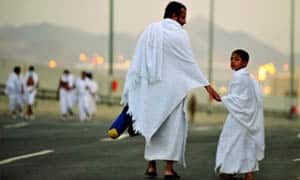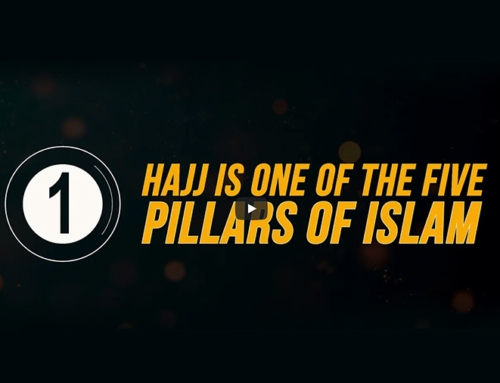By: Ni’mah Isma’il Nawwab
The Hajj: A Spiritual Journey for Muslims from All Over the World
The hajj, or pilgrimage to Makkah, a central duty of Islam whose origins date back to the Prophet Abraham, brings together Muslims of all races and tongues for one of life’s most moving spiritual experiences.
For 14 centuries, countless millions of Muslims, men and women from the four corners of the earth, have made the pilgrimage to Makkah, the birthplace of Islam. In carrying out this obligation, they fulfill one of the five “pillars” of Islam, or central religious duties of the believer.
Muslims trace the recorded origins of the divinely prescribed pilgrimage to the Prophet Abraham, or Ibrahim, as he is called in Arabic. According to the Qur’an, it was Abraham who, together with Ishmael (Isma’il), built the Ka’bah, “the House of God,” the focal point toward which Muslims turn in their worship five times each day. It was Abraham, too – known as Khalil Allah, “the friend of God” – who established the rituals of the hajj, which recall events or practices in his life and that of Hagar (Hajar) and their son Ishmael.
The Hajj: A Once-in-a-Lifetime Pilgrimage to the Heart of Islam
In the chapter entitled “The Pilgrimage,” the Qur’an speaks of the divine command to perform the hajj and prophesies the permanence of this institution:
“And when We assigned for Abraham the place of the House, saying ‘Do not associate Anything with Me, and purify My House for those who go around it and for those who stand and bow and prostrate themselves in worship. And proclaim the Pilgrimage among humankind: They will come to you on foot and on every camel made lean by traveling deep, distant ravines…'” (Quran 22:26)
The hajj to Makkah is a once-in-a-lifetime obligation upon male and female adults whose health and means permit it, or, in the words of the Qur’an, upon “those who can make their way there.” It is not an obligation on children, though some children do accompany their parents on this journey.
Hajj: A Spiritual Journey with a Strict Preparation
Before setting out, a pilgrim should redress all wrongs, pay all debts, plan to have enough funds for his own journey and for the maintenance of his family while he is away, and prepare himself for good conduct throughout the hajj.
When pilgrims undertake the hajj journey, they follow in the footsteps of millions before them. Nowadays hundreds of thousands of believers from over 70 nations arrive in the Kingdom of Saudi Arabia by road, sea and air every year, completing a journey now much shorter and in some ways less arduous than it often was in the past.
Till the 19th century, traveling the long distance to Makkah usually meant being part of a caravan. There were three main caravans: the Egyptian one, which formed in Cairo; the Iraqi one, which set out from Baghdad; and the Syrian, which, after 1453, started at Istanbul, gathered pilgrims along the way, and proceeded to Makkah from Damascus.
The Hajj: A Spiritual Journey with a Long and Dangerous History
As the hajj journey took months if all went well, pilgrims carried with them the provisions they needed to sustain them on their trip. The caravans were elaborately supplied with amenities and security if the persons traveling were rich, but the poor often ran out of provisions and had to interrupt their journey in order to work, save up their earnings, and then go on their way. This resulted in long journeys which, in some cases, spanned ten years or more. Travel in earlier days was filled with adventure. The roads were often unsafe due to bandit raids. The terrain the pilgrims passed through was also dangerous, and natural hazards and diseases often claimed many lives along the way. Thus, the successful return of pilgrims to their families was the occasion of joyous celebration and thanksgiving for their safe arrival.
Lured by the mystique of Makkah and Madinah, many Westerners have visited these two holy cities, on which the pilgrims converge, since the 15th century. Some of them disguised themselves as Muslims; others, who had genuinely converted, came to fulfill their duty. But all seem to have been moved by their experience, and many recorded their impressions of the journey and the rituals of the hajj in fascinating accounts. Many hajj travelogues exist, written in languages as diverse as the pilgrims themselves.
The Ihram: A White Seamless Garment that Symbolizes Purity and Equality
The pilgrimage takes place each year between the eighth and the 13th days of Dhu al-Hijjah, the 12th month of the Muslim lunar calendar. Its first rite is the donning of the ihram.
The ihram, worn by men, is a white seamless garment made up of two pieces of cloth or toweling; one covers the body from waist to ankle and the other is thrown over the shoulder. This garb was worn by both Abraham and Muhammad. Women generally wear a simple white dress and a headcovering, but not a veil. Men’s heads must be uncovered; both men and women may use an umbrella.
The ihram is a symbol of purity and of the renunciation of evil and mundane matters. It also indicates the equality of all people in the eyes of God. When the pilgrim wears his white apparel, he or she enters into a state of purity that prohibits quarreling, committing violence to man or animal and having conjugal relations. Once he puts on his hajj clothes the pilgrim cannot shave, cut his nails or wear any jewelry, and he will keep his unsown garment on till he completes the pilgrimage.
The Talbiyah: The Primary Invocation of the Hajj
A pilgrim who is already in Makkah starts his hajj from the moment he puts on the ihram. Some pilgrims coming from a distance may have entered Makkah earlier with their ihram on and may still be wearing it. The donning of the ihram is accompanied by the primary invocation of the hajj, the talbiyah:
Here I am, O God, at Thy Command! Here I am at Thy Command! Thou art without associate; Here I am at Thy Command! Thine are praise and grace and dominion! Thou art without associate.
The thunderous, melodious chants of the talbiyah ring out not only in Makkah but also at other nearby sacred locations connected with the hajj.
On the first day of the hajj, pilgrims sweep out of Makkah toward Mina, a small uninhabited village east of the city. As their throngs spread through Mina, the pilgrims generally spend their time meditating and praying, as the Prophet did on his pilgrimage.
Hajj: The Wuquf at ‘Arafat, the Culmination of a Pilgrim’s Spiritual Journey
During the second day, the 9th of Dhu al-Hijjah, pilgrims leave Mina for the plain of ‘Arafat for the wuquf, “the standing,” the central rite of the hajj. As they congregate there, the pilgrims’ stance and gathering reminds them of the Day of Judgment. Some of them gather at the Mount of Mercy, where the Prophet delivered his unforgettable Farewell Sermon, enunciating far-reaching religious, economic, social and political reforms. These are emotionally charged hours, which the pilgrims spend in worship and supplication. Many shed tears as they ask God to forgive them. On this sacred spot, they reach the culmination of their religious lives as they feel the presence and closeness of a merciful God.
The Wuquf at ‘Arafat: A Pilgrim’s Journey to Spiritual Exaltation
The first Englishwoman to perform the hajj, Lady Evelyn Cobbold, described in 1934 the feelings pilgrims experience during the wuquf at ‘Arafat. “It would require a master pen to describe the scene, poignant in its intensity, of that great concourse of humanity of which I was one small unit, completely lost to their surroundings in a fervor of religious enthusiasm. Many of the pilgrims had tears streaming down their cheeks; others raised their faces to the starlit sky that had witnessed this drama so often in the past centuries. The shining eyes, the passionate appeals, the pitiful hands outstretched in prayer moved me in a way that nothing had ever done before, and I felt caught up in a strong wave of spiritual exaltation. I was one with the rest of the pilgrims in a sublime act of complete surrender to the Supreme Will which is Islam.”
The Prophet’s Last Address: How Pilgrims Feel Close to Him at ‘Arafat
She goes on to describe the closeness pilgrims feel to the Prophet while standing in ‘Arafat: “…as I stand beside the granite pillar, I feel I am on Sacred ground. I see with my mind’s eye the Prophet delivering that last address, over thirteen hundred years ago, to the weeping multitudes. I visualize the many preachers who have spoken to countless millions who have assembled on the vast plain below; for this is the culminating scene of the Great Pilgrimage.”
The Prophet is reported to have asked God to pardon the sins of pilgrims who “stood” at ‘Arafat, and was granted his wish. Thus, the hopeful pilgrims prepare to leave this plain joyfully, feeling reborn without sin and intending to turn over a new leaf.
The Stoning of the Devil: A Symbol of Humans’ Attempt to Cast Away Evil
Just after sunset, the mass of pilgrims proceeds to Muzdalifah, an open plain about halfway between ‘Arafat and Mina. There they first pray and then collect a fixed number of chickpea-sized pebbles to use on the following days.
Before daybreak on the third day, pilgrims move en masse from Muzdalifah to Mina. There they cast at white pillars the pebbles they have previously collected. According to some traditions, this practice is associated with the Prophet Abraham. As pilgrims throw seven pebbles at each of these pillars, they remember the story of Satan’s attempt to persuade Abraham to disregard God’s command to sacrifice his son.
Throwing the pebbles is symbolic of humans’ attempt to cast away evil and vice, not once but seven times – the number seven symbolizing infinity.
Following the casting of the pebbles, most pilgrims sacrifice a goat, sheep or some other animal. They give the meat to the poor after, in some cases, keeping a small portion for themselves.
This rite is associated with Abraham’s readiness to sacrifice his son in accordance with God’s wish. It symbolizes the Muslim’s willingness to part with what is precious to him, and reminds us of the spirit of Islam, in which submission to God’s will plays a leading role. This act also reminds the pilgrim to share worldly goods with those who are less fortunate, and serves as an offer of thanksgiving to God.
The Tawaf: A Symbol of Unity and Harmony in the Hajj
As the pilgrims have, at this stage, finished a major part of the hajj, they are now allowed to shed their ihram and put on everyday clothes. On this day Muslims around the world share the happiness the pilgrims feel and join them by performing identical, individual sacrifices in a worldwide celebration of ‘Id al-Adha, “the Festival of Sacrifice.” Men either shave their heads or clip their hair, and women cut off a symbolic lock, to mark their partial deconsecration. This is done as a symbol of humility. All proscriptions, save the one of conjugal relations, are now lifted.
Still sojourning in Mina, pilgrims visit Makkah to perform another essential rite of the hajj: the tawaf, the seven-fold circling of the Ka’bah, with a prayer recited during each circuit. Their circumambulation of the Ka’bah, the symbol of God’s oneness, implies that all human activity must have God at its center. It also symbolizes the unity of God and man.
Thomas Abercrombie, a convert to Islam and a writer and photographer for National Geographic Magazine, performed the hajj in the 1970’s and described the sense of unity and harmony pilgrims feel during the circling: “Seven times we circled the shrine,” he wrote, “repeating the ritual devotions in Arabic: ‘Lord God, from such a distant land I have come unto Thee…. Grant me shelter under Thy throne.’ Caught up in the whirling scene, lifted by the poetry of the prayers, we orbited God’s house in accord with the atoms, in harmony with the planets.”
The Black Stone: A Sacred Relic at the Heart of the Hajj
While making their circuits pilgrims may kiss or touch the Black Stone. This oval stone, first mounted in a silver frame late in the seventh century, has a special place in the hearts of Muslims as, according to some traditions, it is the sole remnant of the original structure built by Abraham and Ishmael. But perhaps the single most important reason for kissing the stone is that the Prophet did so.
No devotional significance whatsoever is attached to the stone, for it is not, nor has ever been, an object of worship. The second caliph, ‘Umar ibn al-Khattab, made this crystal clear when, on kissing the stone himself in emulation of the Prophet, he proclaimed: “I know that you are but a stone, incapable of doing good or harm. Had I not seen the Messenger of God kiss you – may God’s blessing and peace be upon him – I would not kiss you.”
The Sa’y: A Pilgrim’s Reenactment of Hagar’s Desperate Search for Water
After completing the tawaf, pilgrims pray, preferably at the Station of Abraham, the site where Abraham stood while he built the Ka’bah. Then they drink of the water of Zamzam.
Another, and sometimes final, rite is the sa’y, or “the running.” This is a reenactment of a memorable episode in the life of Hagar, who was taken into what the Qur’an calls the “uncultivable valley” of Makkah, with her infant son Ishmael, to settle there.
The sa’y commemorates Hagar’s frantic search for water to quench Ishmael’s thirst. She ran back and forth seven times between two rocky hillocks, al-Safa and al-Marwah, until she found the sacred water known as Zamzam. This water, which sprang forth miraculously under Ishmael’s tiny feet, is now enclosed in a marble chamber near the Ka’bah.
The Hajj: A Pilgrimage of Faith and Renewal, with a Visit to the Prophet’s Mosque in Madinah
These rites performed, the pilgrims are completely deconsecrated: They may resume all normal activities. According to the social customs of some countries, pilgrims can henceforth proudly claim the title of al-Hajj or Hajji.
They now return to Mina, where they stay up to the 12th or 13th day of Dhu al-Hijjah. There they throw their remaining pebbles at each of the pillars in the manner either practiced or approved by the Prophet. They then take leave of the friends they have made during the Hajj. Before leaving Makkah, however, pilgrims usually make a final tawaf round the Ka’bah to bid farewell to the Holy City.
Before or after going to Makkah, pilgrims also avail themselves of the opportunity provided by the hajj to visit the Prophet’s Mosque in Madinah, the second holiest city in Islam. Here, the Prophet lies buried in a simple grave under the green dome of the mosque. The visit to Madinah is not obligatory, as it is not part of the hajj, but the city – which welcomed Muhammad when he migrated there from Makkah – is rich in moving memories and historical sites that are evocative of him as a prophet and statesman.
The Prophet’s Spirit Still Alive in Madinah, the City of Love
In this city, loved by Muslims for centuries, people still feel the presence of the Prophet’s spirit. Muhammad Asad, an Austrian Jew who converted to Islam in 1926 and made five pilgrimages between 1927 and 1932, comments on this aspect of the city: “Even after thirteen centuries [the Prophet’s] spiritual presence is almost as alive here as it was then. It was only because of him that the scattered group of villages once called Yathrib became a city and has been loved by all Muslims down to this day as no city anywhere else in the world has ever been loved. It has not even a name of its own: for more than thirteen hundred years it has been called Madinat an-Nabi, ‘the City of the Prophet.’ For more than thirteen hundred years, so much love has converged here that all shapes and movements have acquired a kind of family resemblance, and all differences of appearance find a tonal transition into a common harmony.”
As pilgrims of diverse races and tongues return to their homes, they carry with them cherished memories of Abraham, Ishmael, Hagar, and Muhammad. They will always remember that universal concourse, where poor and rich, black and white, young and old, met on equal footing.
The Hajj: A Pilgrimage of Awe, Serenity, and Hope
They return with a sense of awe and serenity: awe for their experience at ‘Arafat, when they felt closest to God as they stood on the site where the Prophet delivered his sermon during his first and last pilgrimage; serenity for having shed their sins on that plain, and being thus relieved of such a heavy burden. They also return with a better understanding of the conditions of their brothers in Islam. Thus is born a spirit of caring for others and an understanding of their own rich heritage that will last throughout their lives.
The pilgrims go back radiant with hope and joy, for they have fulfilled God’s ancient injunction to humankind to undertake the pilgrimage. Above all, they return with a prayer on their lips: May it please God, they pray, to find their hajj acceptable, and may what the Prophet said be true of their own individual journey: “There is no reward for a pious pilgrimage but Paradise.”
This article appeared in ARAMCO World, July-August 1992.
Got Questions?
We have Answers. Get in touch now.








